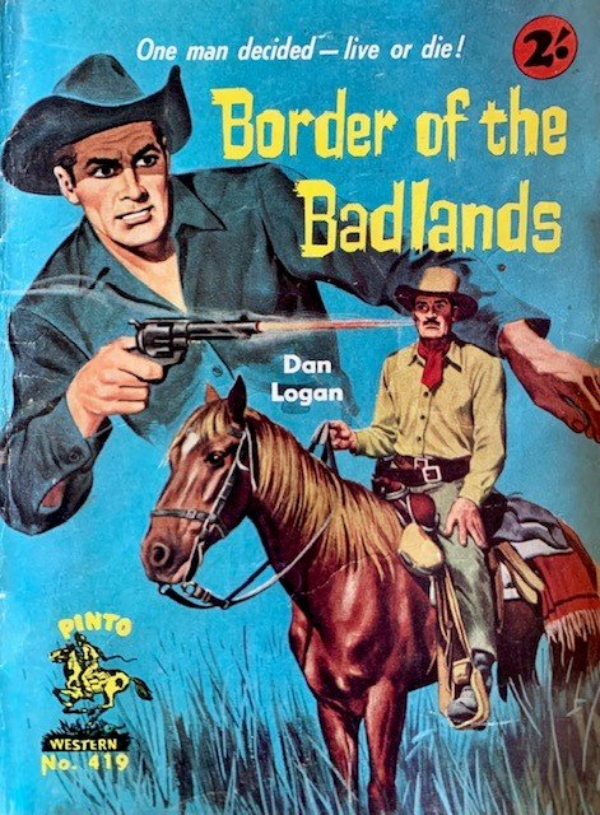TRASHY TUESDAY: MORE EARLY AUSTRALIAN PULP WESTERNS FROM CLEVELAND
In a recent post I highlighted a bunch of early Australian digest westerns from Cleveland publishing that I had acquired: TRASHY TUESDAY: CLEVELAND WESTERNS | Murder Mayhem and Long Dogs
I now have another batch, including a very early novel by Marshall Grover (pseudonym for Leonard F Meares).
As I mentioned in the previous post, Cleveland Publishing was established in 1953 and continued publishing soft cover digests, primarily westerns, up until December 2018. Cleveland published in a range of different genres, including romance, spy fiction and the Larry Kent crime series, but are probably best known for their westerns, which were a staple in Australian newsagents well into recent years.
At its peak Cleveland had several different western series; including Sierra Western, High Brand Western, Bighorn Western and Winchester Western, to name a few. They produced around 18 different westerns each month and printed up to 50,000 copies of each book. The books were usually 113 pages and were printed in digest style with staples.
For several years Marshall Grover was a major drawcard for Cleveland Publishing with his Larry and Stretch series, until he shifted to Horwitz Books in 1966. Marshall Grover was a prolific author credited with writing nearly 750 books, most of which were westerns. Best known for this Larry and Stretch series (changed to Larry and Streak in the United States and, bizarrely, Bill and Ben in Nordic countries), Grover also created several other series, and many stand alone novels.
Whiplash is a very early novel by Grover/Meares and is not in the Larry and Stretch series. From what I can work out, it is probably the eleventh book he did for Cleveland (some of the initial ones appeared under the Johnny Nelson pseudonym) and came out in 1956.
By the way do not be fooled by the numbering on the books, the Cleveland Books started with number 501 in 1954 and most of the sequent western series also started in the hundreds, for instance Chisholm Westerns started at 648.
Cleveland did not credit the cover artists, until the use of Spanish illustrators in the late 1960s, but most of the early covers were done by either Stan Pitt or Walter Stackpool. Whiplash looks like a Stan Pitt cover to me, but I am not sure. It is pretty good though.
Shad Denver was one of the pseudonyms used by Grover/Meares and Winchester Decision (Bighorn Western #329) is one of his early ones from the mid 1950s (Bighorn Western started at #300 in the mid 1950s). It was probably published in 1956 or 1957. Again the cover is likely to have been done by Stanley Pitt.
Dan Logan was a name that appeared across the Cleveland Western series. I assume that it is a pseudonym but I could not find anything on Logan.
Border Of The Badlands (Pinto Westerns #419) was probably from the earlier 1960s, but before decimal currency in 1966.
The cover is quite good, but the positioning of the two pictures is a little odd, with the bullet track appearing to go into the rider’s ear!
Clint McCall was a pseudonym initially used by the very prolific Keith Hetherington (he wrote around 4 books a month at his peak) for his Cleveland westerns in the mid 1950s. It was then passed to another unknown author.
Malloy (Bison Western #403) is a later book, probably 1967, and is unlikely to have been written by Hetherington.
The cover has a more 60s feel to it, than the earlier books. I like the dynamic nature of the drawing and the very long cigarette hanging out of the gunman’s mouth!
The Shane and Jonah series was created by Cole Shelton (Roger Norris-Green) as a competitor to the popular Larry and Stretch books, which switched to Horwitz in 1966. The pricing would suggest that Bullet For A Sheepman dates from the late 1960s.
The cover very clearly features Dean Martin from his Sons Of Katie Elder/Bandolero period. It was quite common for Cleveland westerns to feature drawings of western actors on their covers (see John Wayne below). The cover has a slightly more gritty feel and was a forerunner for the more violent and sexual covers that the Spanish syndicated art agency Nova Bossa brought to the Cleveland western covers from the late 1960s, through artists such as Rafael Cortiella and Enrich Torres.
I will continue to look out for more early Cleveland westerns. They are relatively easy to find, although they are often in poor condition and usually have writing on their covers.








